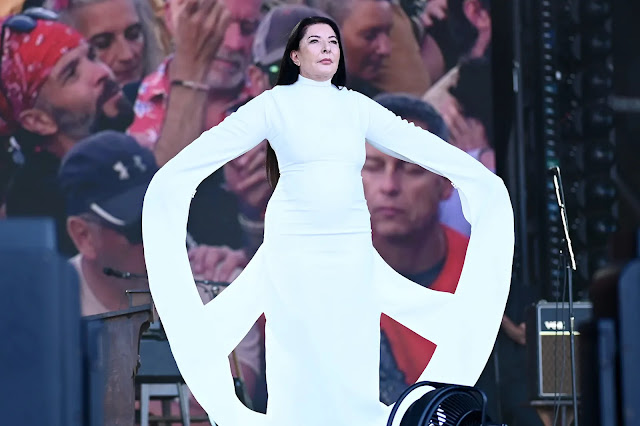GLASTONBURY: On Friday, Marina Abramović orchestrated a collective seven-minute silence at the UK’s largest music festival. To emphasize her message, the Serbian artist donned a white sculptural column dress that transformed into a peace sign when she outstretched her arms.
Renowned for her bold performance art, Abramović once allowed the public to interact with her during a six-hour sitting in her 1974 piece, "Rhythm 0," which culminated in a loaded gun being pointed at her head.
On the Glastonbury main stage, Abramović urged the festival’s 250,000 attendees to introspect. “People come to have a good time. They’re drinking, taking drugs, the weather is good,” she told Vogue before the event. “But I’m asking them to be silent and to reflect on the state of this planet, which is really hell right now.”
In addition to silencing the festival, Abramović’s outfit was a powerful statement. Her dress, designed by her friend and former Burberry creative director Riccardo Tisci, was inspired by the Japanese kimono. Standing tall, the fabric extended from her shoulders to create a peace sign, with her hands enveloped in the large white sleeves and more fabric forming an upside-down ‘V’ at hip level. Abramović noted that the dress will eventually be displayed in a museum.
While we’re used to seeing peace signs on crop tops and canvas tote bags, Abramović and Tisci’s real-life rendering is much closer to the symbol’s origin. The peace icon was designed by British artist Gerald Holtom and first appeared during a London peace march in 1958. It was later adopted by the Campaign for Nuclear Disarmament (CND). Holtom explained that the sign’s inspiration came from his own human form: “I drew myself: the representation of an individual in despair, with hands and palms outstretched, outwards and downwards in the manner of Goya’s peasant before the firing squad. I formalized the drawing into a line and put a circle round it.”
More than six decades later, Holtom’s peace sign has become one of the world’s most recognized symbols, especially in fashion. Over the years, it has adorned everything from Fendi Baguette bags to Dior knitwear. In 2014, Moschino transformed the design into luxurious pendants on heavy, golden chains. The following year at Chanel, it appeared in Sharpie-style scrawl on distressed messenger bags, punctuating the phrase “Make fashion, not war.”
Abramović’s outfit aligned with Glastonbury’s 2024 theme: Peace. Holtom’s sign was visible throughout the festival, crowning the roof of the newly erected Peace Stage and appearing in the sky during the event’s first-ever drone display earlier in the week.
Facing the crowd, Abramović embraced the symbol sewn into her dress. “See how we can feel positive energy in the entire universe,” she told onlookers. What began for Holtom as a mark of despair had transformed into an open embrace.
#MarinaAbramović #Glastonbury2024 #PeaceSign #PerformanceArt #RiccardoTisci #FashionAndArt #HoltomPeaceSign #CND #PeaceStage #FestivalFashion #ArtInFashion #PositiveEnergy #MakeFashionNotWar





0 Comments: